How to Eliminate Foam Smell From Small Exercise Floor
Best Home Gym Flooring Options
So you're ready to build your home gym. It's so exciting! You can finally get in your workout even when you can't make it to the local gym. But wait! There's one critical piece that is often forgotten – your floor!
The floor is one of the most essential pieces in your home gym. It's important to choose a floor that can protect both your joints and your subfloor from the demands of your fitness routine.
Get started on your home gym with our top options for home gym flooring. Use this guide to choose from rubber, foam, carpet, turf, or vinyl, and find the best option for you.
Rubber Gym Flooring
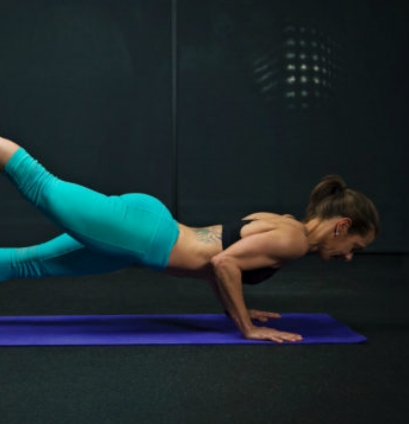
Rubber is the premier gym flooring option. Walk into just about any gym or fitness studio and you're certain to see they use rubber flooring.
While you have many choices when it comes to gym flooring options, rubber is the most versatile, lending itself to just about any workout. It is also the most likely to protect your subfloor from the impact of heavy weights while you lift.
Rubber gym flooring is available in tiles, rolls, and mats. Each option has a wide range of thickness options to suit your needs.
To make your space look sharp, you can choose between a wide variety of color and color fleck options. My gym uses the orange color fleck rolls to match their orange accent wall. You have lots of possibilities.
Let's take a look at your options.
Rubber Gym Floor Tiles
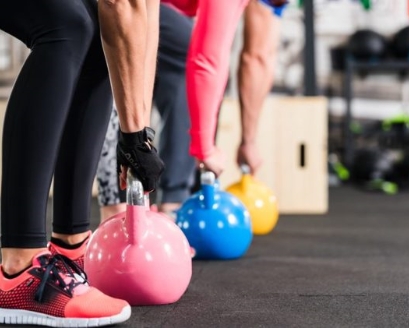
Rubber tiles are the most popular home gym flooring option on the market. They are durable, affordable, and known for their easy, DIY, interlocking installation.
Homeowners love that installing rubber tiles is just like putting together a giant, life-size rubber puzzle. Each tile contains interlocking edges that fit together in seconds.
Choose from multiple thickness options to find the right choice to protect your subfloor. If you plan to drop some 100 lb. dumbbells, you'll want to choose a thicker rubber tile.
Rubber Gym Flooring Rolls
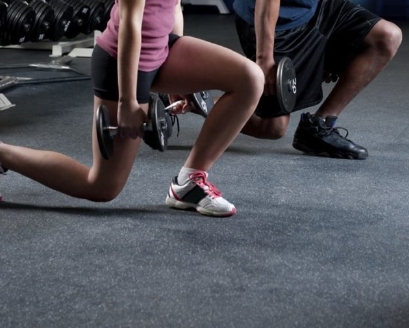
Rubber rolls are known for their seamless appearance. When installed correctly, it is nearly impossible to see where one roll ends and another begins.
Rubber gym flooring rolls come in a variety of different thickness options to suit your needs. You can even purchase high-impact rubber rolls specially designed to keep your joints safe during high-impact, plyometric movements.
Rubber Gym Floor Mats
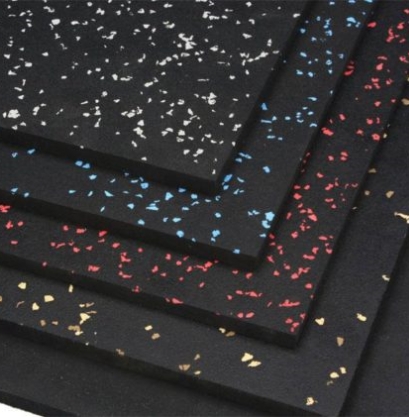
Sometimes it's more convenient to have a rubber mat to provide you with the right amount of durability, density, and portability for your home gym. Especially if you are working on your elliptical while watching your favorite reality tv show.
But seriously, sometimes you just need to cover a small area, for example, a weightlifting station, underneath your treadmill, or just a small space to do your ab work without your tailbone digging into your tile floor.
Rubber mats are perfect for that!
You can choose anything from thin 1/4" mats for bodyweight exercises up to 3/4" Shock Mats, which are specially designed to handle the impact of heavy Olympic weightlifting and dumbbell exercises.
Pros of Rubber Flooring
- Easy to install: Whether you choose tiles, rolls, or mats, you can install rubber flooring in your home gym without the help of an installation professional. Just make sure you have some friends to help if you choose rubber rolls because they get pretty heavy.
- Ultra-durable: Rubber flooring is perhaps the most durable home gym flooring option available. You will even see rubber flooring installed in ice skating rinks where skaters walk with their ice skates. And still, you won't need to replace the floor for 10+ years.
- Best shock absorption: For tough workouts and heavy weights, rubber gym flooring will absorb the shock, keeping your joints and subfloor safe and sound.
- Easy to clean: Just vacuum or use a damp mop when necessary.
- Antimicrobial: That's a fancy way to say you won't see weird things growing on your floor.
- Water-resistant: Sweat your heart out and create your home gym on any level, including your basement. Rubber isn't particular.
- Excellent sound absorption: Drop those weights and pound away on the treadmill – rubber will help absorb the sound and keep your neighbors from hating you.
Cons of Rubber Gym Flooring
- Weight: With all that durability comes a pretty bulky floor that weighs quite a bit. If you choose rolled rubber gym flooring, you'll want to enlist the help of friends to help with installation.
- Little temperature insulation: Rubber is a bad insulator against temperature transmission. When you use rubber on cold basement subfloors, the rubber will still feel cold to the touch. However, rubber works well over heated flooring systems.
- Price: Some rubber home gym flooring options to get pretty pricey. Although it may not always be the cheapest option, it does typically provide the best value.
- Smell: New rubber flooring sometimes comes with a distinct rubber odor. Fortunately, you can address this by mopping the flooring with a mix of soap and water a few times and keeping the area well-ventilated.
Rubber Gym Flooring Installation
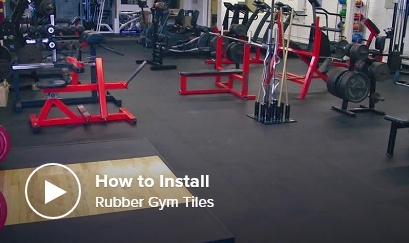
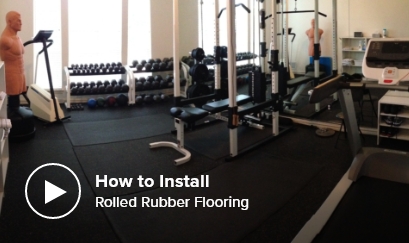
Rubber gym flooring is super easy to install on your own or with a little help from your friends. You have a few options when it comes to installation methods.
- Loose lay home gym flooring: If you are loose laying your rubber flooring, you're done after you lay it down. Seriously! Most of the time, the rubber is heavy enough to naturally stay in place with no extra adhesive necessary. If you loose lay your gym flooring, you can easily pick it up and move it at any time.
- Double-sided tape: For more intense conditions, consider using double-sided carpet tape around the perimeter of your floor. This is extremely easy and you will still be able to transport your rubber gym flooring if you change locations.
- Glue-down: In extreme conditions, some CrossFit and high-intensity athletes prefer to fully glue down their rubber gym flooring. This is for rubber gym flooring rolls only and will ensure no movement and no curling up at the edges. However, once the rolls are glued, they cannot go with you if you move locations.
Foam Gym Flooring
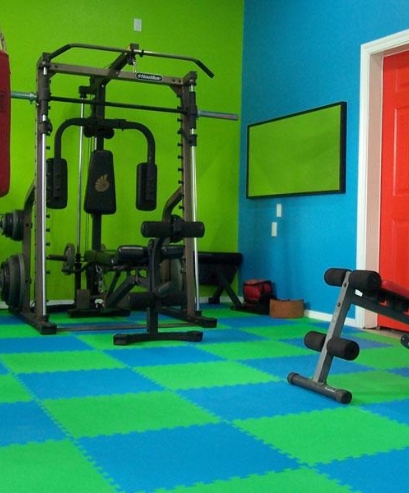
For the lightest and most affordable home gym flooring, soft foam tiles are where it's at. With tons of fun colors and beautiful wood looks to choose from, you can easily jazz up your space with this popular home gym flooring option.
Foam is great for bodyweight exercises and light workouts. Installation is truly a DIY dream. Just lay your foam down, interlock the tiles (if you choose tiles), and voila! Foam gym flooring in minutes,
I mentioned that rubber flooring is pretty heavy. It's like the bodybuilder of gym flooring. Foam is super light, more like a long-distance runner.
While it can't hold up to intense dumbbells and Olympic lifting the way rubber can, it is a great option for any starter home gym.
Foam gym flooring is typically sold in interlocking tiles and mats. The tiles are most commonly referred to as soft tiles, foam tiles, or puzzle lock tiles.
Choose from different thicknesses and looks to find the perfect foam home gym flooring for your space.
HD Foam Gym Flooring
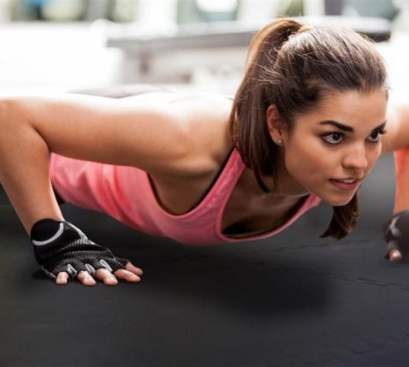
So I know I said foam flooring wasn't a great option for heavier workouts, but I have an amendment to that statement.
HD Soft Tiles and Premium HD Soft Tiles are the exceptions to the rule. They give you the cost of foam gym flooring with the versatility and durability of rubber.
These soft foam tiles can take the abuse of heavy weights and plyometric (jumping) movements.
Our HD Soft Tiles are made from high-density foam, making them durable to stand up to your heavy power cleans. They are so sturdy, you can even use them for horse stalls!
Pros of Foam Gym Flooring
- Price: Foam is the least expensive home gym flooring on the market.
- Lots of cushion: This is ideal for athletes who do a lot of floor work such as sit-ups and stretching.
- Easy to clean: If your tiles get dirty, just wipe them down with a damp cloth and they'll look like new.
- Safe for kiddos: Parents love that foam tiles also provide a safe surface for kiddos, absorbing the shock of those learning-to-walk tumbles. Go ahead and make the most out of your space, using it as a home gym and play area.
- Lightweight: Foam gym flooring is super light, which makes it super portable.
- Easy to install: Lock the tiles together on the floor and you're done.
- Color and look options: Many home users also choose foam tiles since they can mix and match colors to form custom designs like checkerboard or border patterns.
Cons of Foam Gym Flooring
- Not recommended for heavy weights and equipment: Unfortunately, it's easy to compress foam tiles under heavy weight equipment. The foam won't completely bounce back if it's compressed for too long.
- No sharp objects: You can easily puncture, cut, or slice foam with sharp objects. That's why we do not recommend walking on any type of foam flooring with high heeled shoes.
Note: The above statements do not apply to the HD Soft Tiles.
Foam Gym Flooring Installation
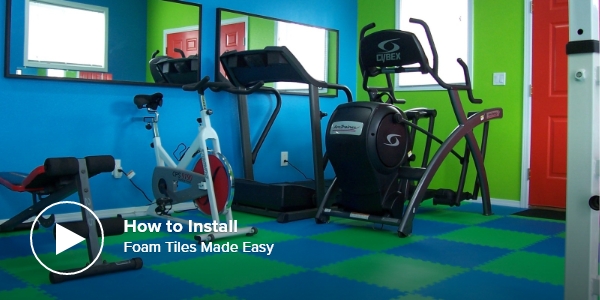
Foam gym flooring is super easy to install on your own in just minutes. You have a few options when it comes to installation methods.
- Loose lay home gym flooring: If you are loose laying your foam flooring after you lay it down, you are done! With this method, you can easily pick it up and move it at any time.
- Double-sided tape: Since foam is lightweight, it can require a little security to keep it in place during your workouts. For a more stable environment, consider using double-sided carpet tape around the perimeter of your floor. This is extremely easy and you will still be able to transport your foam gym flooring if you change locations.
Carpet Tile Gym Flooring
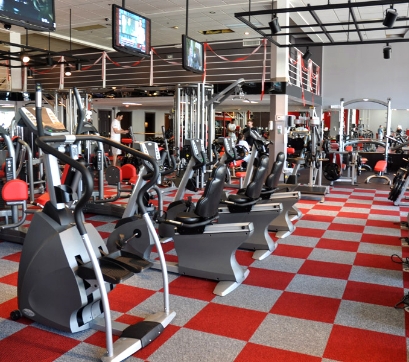
Carpet is the most popular floor covering option in America. All-purpose, relatively inexpensive, comfortable to the touch, and fairly easy to clean and maintain, carpet is an excellent home gym flooring solution.
Now, we don't mean a thick, plush living room carpet. That isn't gonna work. Instead, for home gym flooring, we recommend a short, thin, low-pile carpet.
Low-pile is usually much more durable than fluffy shag or even soft Berber style carpets often found in homes. Commercial-grade carpet also works very well for home gyms due to its tight-knit loops.
One other form of carpet often used for exercise flooring is interlocking carpet tiles. These tiles interlock and are super DIY-friendly.
Pros of Carpet Tile Gym Flooring
- Durable: Carpet tiles are extremely durable gym flooring. They can hold up to many years of abuse before you need to replace them.
- Approachable: Carpet is also a favorite gym flooring option since the average person completely understands and already knows how to take care of it.
- A touch of softness: Just like foam, carpet can provide a multi-use space perfect for workouts and family time.
- Safe for kiddos: Parents love that foam tiles also provide a safe surface for kiddos, absorbing the shock of those learning-to-walk tumbles. Go ahead and make the most out of your space, using it as a home gym and play area.
- Color options: Carpet tiles are available in a wide array of colors so you can easily choose your perfect look.
Cons of Carpet Tile Gym Flooring
- Trickier installation: While interlocking carpet tiles are easy to install, home gym carpet tiles that don't interlock need to be installed by a professional.
- Water retention: There are some water-resistant carpet gym flooring options. However, others can hold moisture and require professional cleaning every few years.
- Less subfloor protection: While rubber flooring is specifically designed as a protective home gym floor covering, carpet is not made for this and you will need a layer of underlayment to prevent cracks in your subfloor from the stress of heavy weights.
- Rugburn: Have you ever done burpees or sit-ups on carpet? It's not fun.
Carpet Tile Gym Flooring Installation
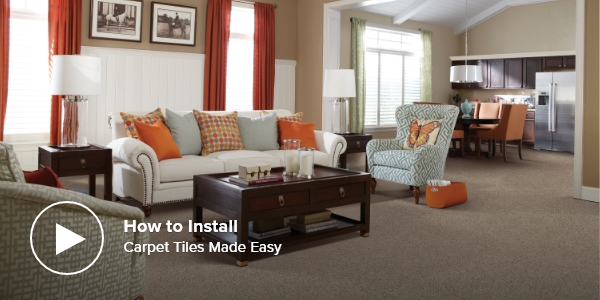
Carpet is hit or miss when it comes to ease of installation. Interlocking and loose lay tile options can be done in a day, while broadloom carpets require a professional. Here are a few installation options.
- Loose lay home gym flooring: If you are using interlocking tiles and/or loose laying your home gym flooring after you lay it down, you are done! If you loose lay your gym flooring, you can easily pick it up and move it at any time.
- Double-sided tape: For more intense conditions, consider using double-sided carpet tape around the perimeter of your floor. This is extremely easy and you will still be able to transport your gym flooring if you change locations.
- Glue-down: In extreme conditions, some CrossFit and high-intensity athletes prefer to fully glue down their carpet gym flooring.
Turf Gym Flooring
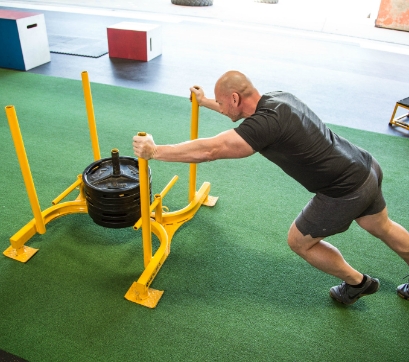
Synthetic turf floors allow you to transform your workout area into a space where you can challenge yourself in fun and varied ways. From strength training and conditioning to yoga and stretching, you can reach your full potential in your workouts with a safe and resilient surface beneath you.
Gym turf is a durable and long-lasting option that is perfect for pulling or pushing sleds, completing your CrossFit WOD, or performing HIIT workouts.
Plus, you can always purchase cushioned turf, which comes with extra benefits. While its sound-absorbing qualities make padded turf perfect for weight lifting and high-intensity work, the softness of the artificial grass provides an inviting space for your yoga mat. Take advantage of the flat, cushioned surface for body-weight work and stretching. Please note: not all turf is suitable for floor exercises because some products are too abrasive. Consider this factor when choosing your product.
Training for a 5k or warrior dash? Many runners practice speedwork on grass because of the lower impact.
If bad weather hits, you can take your workout inside while still getting the safety benefits of grass. Padded gym turf products make a great surface for speed and agility training because they're made to absorb impact, helping to prevent athletic injuries. However, non-padded turf isn't designed to absorb as much impact, so make sure you consider the padding before making a purchase.
While indoor sports turf is most common in commercial gyms, it's also a great option for sharp and functional home gyms.
Pros of Turf Gym Flooring
- Versatile: Artificial turf is a great home gym flooring option for running, calisthenics, CrossFit, and more.
- Traction and cushion: Padded sports turf provides a safe surface that is easier on the joints, allowing athletes to push it to the max with less risk of injury.
- Durability: Synthetic turf can withstand plenty of wear and tear while still looking awesome.
- Appearance: Functional and beautiful? Fake grass gives your gym a modern design element with plenty of functionality.
Cons of Turf Gym Flooring
- Little subfloor protection: While some sports turf options come with an added layer of protection, many require using an underlayment to protect your subfloor if you plan to drop heavy weights.
- Can be abrasive when doing floor exercises: Just like carpet, the turf texture isn't always ideal for exercises like burpees and sit-ups.
- More challenging installation: Home gym turf flooring is not nearly as easy to install as rubber or foam. While turf tiles are DIY-friendly, traditional home gym turf rolls may require an installation professional.
- Price: Artificial turf is not the cheapest gym flooring option there is. However, you can still find options that won't break the bank.
Turf Gym Flooring Installation
Depending on which product you choose, you have three options when installing indoor sports turf.
- Interlocking: If you choose turf tiles, you can just snap them together using the interlocking edges. This is extremely easy and you will be able to transport your synthetic turf gym flooring if you change locations.
- Double-sided tape: For more intense conditions, consider using double-sided carpet tape around the perimeter of your turf. This is simple and you will still be able to transport your gym turf if you change locations.
- Glue-down: For extra stability, you can choose a glue-down installation. This ensures your turf will stay in place. However, once the rolls are glued, they cannot go with you if you move locations.
Soft PVC Vinyl Gym Floor Tiles
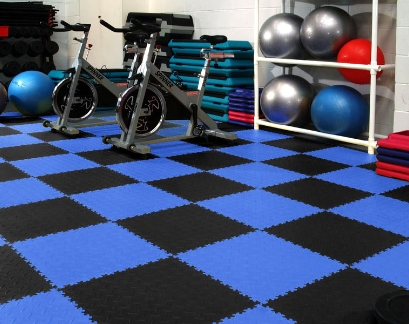
Originally designed as a garage flooring option, soft PVC vinyl tiles are now popular in home gyms, particularly in garage gyms.
Because they were originally created as garage flooring, they are ultra-durable, specially designed to hold up to the weight of heavy vehicles. And your heaviest lifts.
Soft PVC vinyl gym tiles are perfect for the DIY homeowner, with no installation professional necessary.
Customers love the flexibility, durability, and creative looks available with vinyl gym flooring. It's especially great for a multi-use garage where you can both park your vehicle and get fit.
Pros of Vinyl Gym Flooring
- Easy to install: Installing soft PVC vinyl gym tiles is an easy, DIY project.
- Plenty of color options: Create checkered looks or fun patterns to make your space pop.
- Durable: Designed to handle the abuse of cars and trucks, vinyl gym flooring will last for the long haul and usually comes with a hefty warranty.
- Easy to clean: Just a mild soap and water cleaning solution will do the trick. These babies are made to withstand oil and other car chemicals so they do not stain or damage easily.
- Mold, mildew, and chemical resistant: These tiles are an excellent choice for garage home gyms where oils and solvents may be present.
Cons of Vinyl Gym Flooring
- Less shock absorption: The only thing customers tend to dislike about vinyl for home gym flooring is that it's not as shock-absorbent as rubber or foam gym flooring. While these tiles have some flexibility to them, once laid down, they tend to feel more like a durable vinyl floor. It's the type of surface you would find in a kitchen, rather than a shock absorbing gym floor covering.
- Price: These are often a more expensive gym flooring option.
- Patterns: Many vinyl gym flooring options come with either coin or diamond patterns which look great but can cause instability and may not be great for equipment. Smoother options are typically more expensive.
Vinyl Gym Flooring Installation
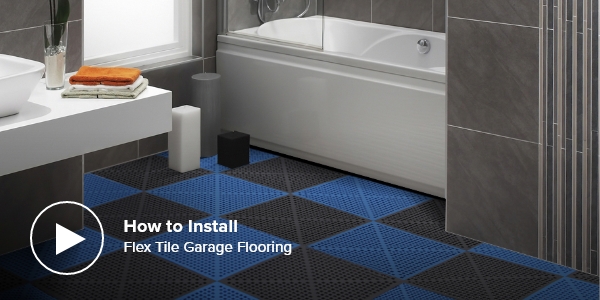
Vinyl gym flooring is super easy to install on your own or with a little help from your friends. Here's what you do when it comes to installation.
- Loose lay home gym flooring: This is a great option for interlocking vinyl tiles. If you are loose laying your rubber flooring, after you lay it down, you are done! Most of the time, the vinyl floor is heavy enough to naturally stay in place with no extra adhesive necessary. If you loose lay your gym floor, you can easily pick it up and move it at any time.
Home Gym Flooring FAQ
That's quite a bit of information! Still have a few questions? Here are a few of our most frequently asked questions about home gym flooring.
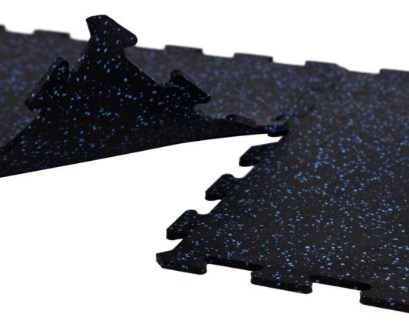
What's the best flooring for home gyms?
Rubber gym floor tiles are by far the most popular home gym flooring option. They are durable, shock-absorbent, and easy to install.
Our most popular home gym flooring tile is our 8mm Strong Rubber Tile. These tiles are perfect for most home workouts and quite affordable. They give the athlete everything they need in one neat little package.
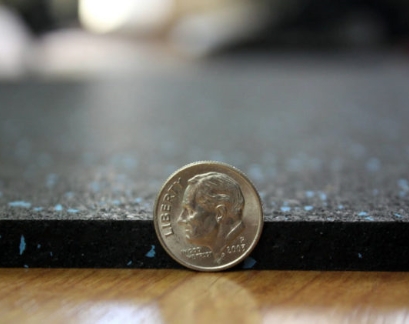
How thick should home gym flooring be?
8mm is the most popular thickness for home gym flooring. However, for CrossFit workouts and Olympic lifting, you'll want at least 3/8". If you plan to repeatedly drop super heavy dumbbells and/or kettlebells, we recommend choosing the ½" just to be safe.
Can you install home gym flooring over carpet?
Yes, you can! You can easily install rubber gym flooring over a short, low-pile carpet. Additionally, you can even install ultra-thick 1" rubber tiles, such as Monster Tiles over plush carpets.
If you go for a different material or thinner tile or rubber roll and cannot rip up your plush carpet, you can lay 1/4" plywood over the plush carpet and install your home gym flooring over your plywood.
How do you clean home gym flooring?
It depends on which option you go with. Most gym flooring options require a simple cleaning solution of mild soap and water.
Each product offers specific instructions on cleaning and maintenance.
Conclusion
Are you pumped to build your own home gym? With the right flooring for your needs, you can start your fitness journey on the right foot. Don't let the inspiration pass you by. Order some free samples of your favorite flooring today!
How to Eliminate Foam Smell From Small Exercise Floor
Source: https://www.rubberflooringinc.com/buyers-guide/home-gym.html